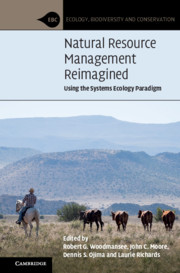Book contents
- Natural Resource Management Reimagined
- Ecology, Biodiversity and Conservation
- Natural Resource Management Reimagined
- Copyright page
- Contents
- Contributors
- Preface
- 1 The Systems Ecology Paradigm
- 2 Environmental and Natural Resource Challenges in the Twenty-First Century
- 3 Evolution of Ecosystem Science to Advance Science and Society in the Twenty-First Century
- 4 Five Decades of Modeling Supporting the Systems Ecology Paradigm
- 5 Advances in Technology Supporting the Systems Ecology Paradigm
- 6 Emergence of Cross-Scale Structural and Functional Processes in Ecosystem Science
- 7 Evolution of the Systems Ecology Paradigm in Managing Ecosystems
- 8 Land/Atmosphere/Water Interactions
- 9 Humans in Ecosystems
- 10 A Systems Ecology Approach for Community-Based Decision Making
- 11 Environmental Literacy
- 12 Organizational and Administrative Challenges and Innovations
- 13 Where to From Here? Unraveling Wicked Problems
- Index
- References
9 - Humans in Ecosystems
Published online by Cambridge University Press: 25 February 2021
- Natural Resource Management Reimagined
- Ecology, Biodiversity and Conservation
- Natural Resource Management Reimagined
- Copyright page
- Contents
- Contributors
- Preface
- 1 The Systems Ecology Paradigm
- 2 Environmental and Natural Resource Challenges in the Twenty-First Century
- 3 Evolution of Ecosystem Science to Advance Science and Society in the Twenty-First Century
- 4 Five Decades of Modeling Supporting the Systems Ecology Paradigm
- 5 Advances in Technology Supporting the Systems Ecology Paradigm
- 6 Emergence of Cross-Scale Structural and Functional Processes in Ecosystem Science
- 7 Evolution of the Systems Ecology Paradigm in Managing Ecosystems
- 8 Land/Atmosphere/Water Interactions
- 9 Humans in Ecosystems
- 10 A Systems Ecology Approach for Community-Based Decision Making
- 11 Environmental Literacy
- 12 Organizational and Administrative Challenges and Innovations
- 13 Where to From Here? Unraveling Wicked Problems
- Index
- References
Summary
During the first decade and a half of the development of the systems ecology paradigm (SEP) most research efforts were placed on learning about how the biophysical realms of ecosystems function and how simulation models could aid gaining that understanding. Missing from that research were the obvious connections of humans as components of ecosystems, not simply as controllers. In 1981 the US National Science Foundation (NSF) Programs Ecosystems Studies and Anthropology funded the South Turkana Ecosystem Project. It was the first time that an ecosystem study had included the human component as a full actor in an ecosystem. The NSF has since created the Dynamics of Coupled Natural and Human Systems program, the sole purpose of which is to fund these types of projects. The human side of SEP has grown in other directions as well including, agro-ecosystem ecology, understanding ecosystem services and effects of land fragmentation, Citizen Science, and providing guidance to the management of natural and human-dominated systems and the improvement of human welfare. Ongoing research has led to the realization that the human residents of the ecosystems under study can engage with research scientists to co-create knowledge about the operation of their own systems.
Keywords
- Type
- Chapter
- Information
- Natural Resource Management ReimaginedUsing the Systems Ecology Paradigm, pp. 279 - 299Publisher: Cambridge University PressPrint publication year: 2021



